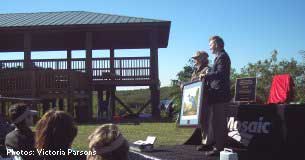|
„This started as a dream that has exceeded our expectations,š said Liz Hunnicutt, supervisor of elementary science education for Hillsborough County. „It‚s relevant, it‚s real, it‚s a motivation to learn and to personally experience the world.š

Top Photo: The Richard T. Paul Boardwalk stretches more than 600 feet over reclaimed tidal channels and mangrove forests.Above: Ann Paul accepts the Guy Bradley Award from David Anderson, president of Audubon of Florida, on behalf of her husband, Rich Paul. The national award is the organization‚s highest honor.
|
A seven-chapter curriculum written for and by teachers who are expected to use the education center is specifically designed to help students prepare for the standardized science tests they take in the fifth grade, Hunnicutt added.
The first students are expected to visit this spring after completing their fourth-grade writing tests in a pilot program open to Apollo Beach, Gibsonton and Riverview elementary schools. „We‚ll start off with one class at a time and see how we manage with 25 students,š said Chris Smith, Mosaic‚s public affairs manager.
The Mosaic Coastal Education Center is an ideal partnership, adds Hunnicutt. „It has the potential to inspire scientists, writers and artists about the mystery and magic of science. Learning is not a spectator sport Ų we need thinkers and doers who can experience the world around them.š
About the Sanctuary and Boardwalk
The Richard T. Paul Sanctuary include two manmade islands ų Bird Island to the east and Sunken Island to the west ų located in Hillsborough Bay at the mouth of the Alafia River. Formed in the late 1920s from spoil material created when a channel was dredged to connect the river to the main shipping channel, the islands immediately became important nesting sites for gulls, terns and skimmers.

Fiddler‚s Dance
Adults attending the dedication got a taste of the interactive curriculum planned for the Coastal Education Center with a sing-a-long featuring Mangrove Mamma and the Propagules.
|
Over the years, as shrubs and trees replaced low-lying vegetation, other birds took up residence including nesting herons, egrets, ibis, and pelicans, which moved from their historic nesting site at Green Key. In 1977, a 12-acre „Alafia Extensionš was added to the west end of Sunken Island, again using materials from a nearby dredging project. Originally planted with smooth cordgrass (Spartina alterniflora), the island is now primarily mangrove forest, with tidal pools, sand and mud flats, and even small creeks and salt barrens.
Today the islands are owned by The Mosaic Company (formerly Cargill Crop Nutrition and IMC Phosphates) and leased to Audubon. The Florida Fish and Wildlife Conservation Commission has listed Alafia Bank as the most important colony in the state, due to its size (number of nesting birds), longevity of nesting activity, and species diversity. Up to 18,000 pairs of 16 to 20 species of birds nest on the islands, making it one of the largest colonies in Florida and one of the most diverse in the continental U.S. The sanctuary also hosts the state‚s largest nesting colony of roseate spoonbills and provides a winter home to a large flock of white pelicans.
The 610-foot boardwalk, made of recycled wood and plastic, stretches from a bluff also created with dredged materials across a restored intertidal ecosystem to the shoreline about 2000 feet from the sanctuaries. Birds are easily viewed through binoculars, but nesting sites are protected from human intrusion.
The education center and boardwalk are currently open only to fourth-grade students in participating schools but Mosaic is evaluating other opportunities. For additional information, contact Mosaic at 813-671-6144.
|